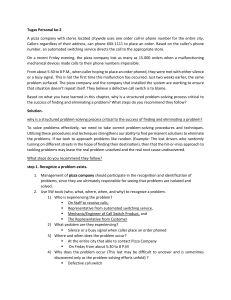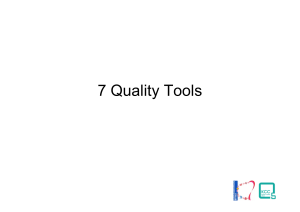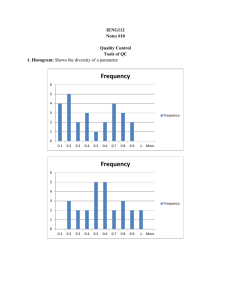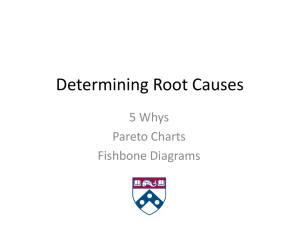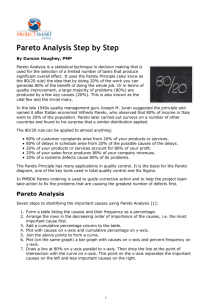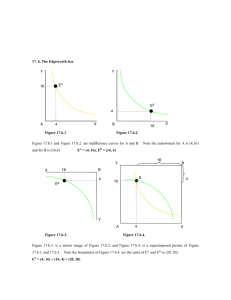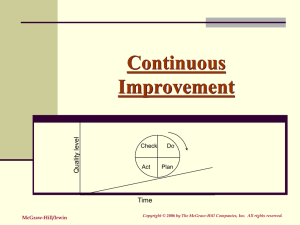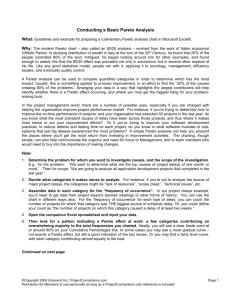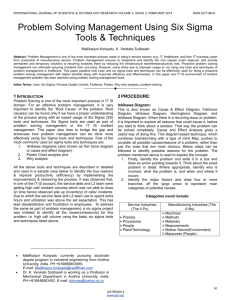SPC TECHNIQUES
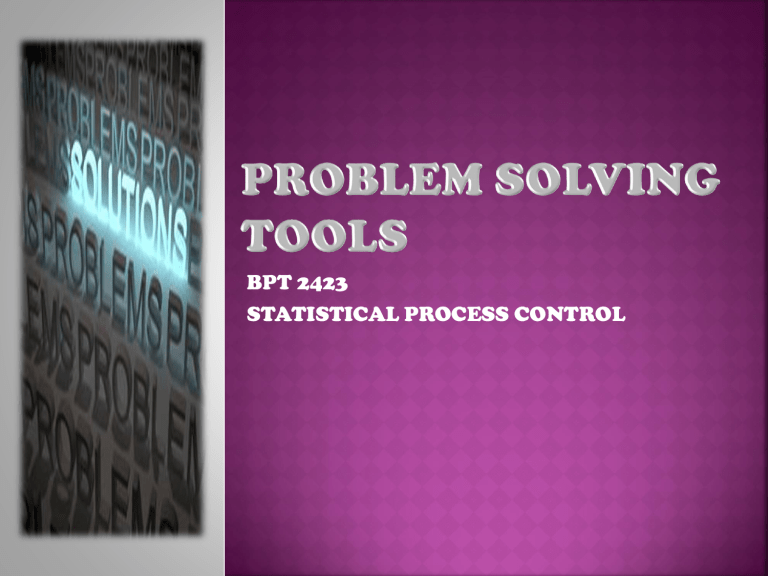
BPT 2423
STATISTICAL PROCESS CONTROL
Problem Solving Process
Quality Tools
1.
Process Flow Diagram
2.
3.
Check Sheet
Histogram
4.
5.
6.
7.
Pareto Chart / Diagram
Cause-and-Effect Diagram
Why-Why Diagram
Scatter Diagram
Understand a variety of techniques for effective problem diagnosis and problem solving
Utilize a systematic problem-solving process: present information clearly and make judgments based on the information
Diagnose and analyze problems that cause variation in the manufacturing, process and service industries
Have you ever been lost? Being lost is different from not being able to find something. In one case, you're unable to locate an object or a place; in the other, you don't know where you are. When you find out where you are, you can figure out where you need to go.
Dealing with problems can be similar to being lost.
Problem solvers need to know where they stand, what the problem really is and what the cause of the problem is before any solutions can be proposed.
Problem solving : the isolation and analysis of a problem and the development of a permanent solution; is an integral part of the quality-improvement process.
Like drivers randomly turning on different streets in the hope of finding their destination, people often find solutions to problems by following a hit-or-miss approach.
Sometimes these solutions attack the symptoms associated with the problem rather than the root cause of the problem.
This leaves the real problem unsolved, the real destination un-reached.
A hit-or-miss type approach to tackling problems is not very effective.
Problem solving is not an automatic process; people need to be trained in correct problem-solving procedures.
Problem-solving efforts should be objective and focused on finding root causes.
Proposed solutions should prevent a recurrence of the problem. Controls should be present to monitor the solution.
Teamwork, motivation, coordinated and directed problem-solving, problem-solving techniques and statistical training are all part of ensuring that problems are isolated, analysed and corrected.
A process map / flowcharts / process flow diagrams is a graphical representation of all the steps involved in an entire process or a particular segment of a process
It is a schematic diagram that shows the flow of the product or service as it moves through the various processing stations or operations
Effectively used in the first stages of problem solving because the charts enable those studying the process to quickly understand what is involved in a process from start to finish
The diagram makes it easy to visualize the entire system, identify potential trouble spots and locate control activities
Because processes and systems are often complex, there are various technique to create a chart - use standardized symbols, constructed with pictures or include additional details like process activities and specifications
Operation Storage Inspection /
Operation
Delay Decision
Main purpose is to ensure that the data are collected carefully and accurately by operating personnel for process control and problem solving
Data should be presented in such a form that it can be quickly and easily used and analyzed
Creativity plays a major role in the design of a check sheet; it should be user friendly and whenever possible, include information on time and location
A data recording device, as events occur in categories, a check or mark is placed on the check sheet in the appropriate category
Given a list of items or events, the user of a check sheet marks down the number of times a particular event or item occurs – the user checks off occurrences
Checklist is differ where it lists all of the important steps or actions that need to take place or things that need to be remembered
Not to confuse a check sheet with a checklist
Data in a ‘form’ are difficult to use and not effective in describing the data’s characteristics
Summarizing the data are needed to show what value the data tend to cluster about and how the data are dispersed or spread out
Identifiable characteristics – variation, shape and location
Can determine the process capability compare with specifications, suggest the shape of the population and indicate if there any gaps in the data
The histogram describes the variation in the process. It is used to :
Solve problems
Determine the process capability
Compare with specifications
Suggest the shape of the population
Indicate discrepancies in data such as gaps
Identified by Vilfredo Pareto (1848 to 1923), conducted studies of the distribution of wealth
Dr. Juran recognized the concept as a universal - he coined the phrases vital few and useful many
Examples of the vital few are:
A few problems account for the bulk of the process downtime
A few suppliers account for the majority of rejected parts
A Pareto diagram is a graph that ranks data classifications in descending order from left to right
A graphical tool for ranking causes of problems from the most significant to the least significant (in descending order from left to right)
A graphical display of the 80-20 rule : 80% of problems come from 20% of causes
Applicable to any problem that can be separated into categories of occurrences – identifying which problems are most significant
It is applicable to problem identification and the measurement of progress
100
80
64
60
40
34
40
20
21
76
83
90
95
100
100
80
60
40
20
10
6 6
5
4
0 0
Normally, the vertical scale is dollars, frequency or percent
Pareto chart is constructed using the following steps:
1.
Determine the method of classifying the data: by problem, cause, nonconformity and so forth
2.
3.
Determine what data to be gathered
Collect data for an appropriate time interval or use historical data
4.
5.
Determine the total number of nonconformities, calculate the percentage in each category and rank order categories from largest to smallest
Construct the diagram and find the vital few
Exercise:
Construct a Pareto diagram for replacement parts for an electric stove. Six month data are : oven door, 193; timer, 53; front burners, 460; rear burners, 290; burner control, 135; drawer rollers, 46 and oven regulators, 265.
Paint nonconformities for a one month period for a riding lawn mower manufacturer are : blister, 212; light spray, 582; drips, 227; overspray, 109; splatter, 141; bad paint, 126; runs, 434; and other,50. Construct a Pareto diagram.
Developed by Dr. Kaoru Ishikawa (1943) – sometimes referred to as Ishikawa diagram / fish-bone diagram because of its shape
Diagram is a picture composed of lines and symbols designed to represent a meaningful relationship between an effect and its causes
Are used to investigate either a "bad" effect and to take action to correct the causes or a "good" effect and to learn those causes responsible; for every effect, there are likely to be numerous causes
Causes are usually broken down into the major causes of work methods, materials, machine, man / people and the environment - each major cause is further subdivided into numerous minor causes
Diagram are useful in:
Analyzing actual conditions for improvement, more efficient use of resources and reduced costs
Elimination conditions causing nonconformities and customer complaint
Educate and train personnel in decision making and corrective action activities
Standardization of existing and proposed operations
To construct a cause-and-effect diagram:
1.
Clearly identify the effect or the problem. Problem statement is placed in a box at the end of a line
2.
3.
Identify the causes. Brainstorming is the usual method for identifying these causes.
Build the diagram. Organize the causes and subcauses in diagram format.
4.
5.
Draw the effect box and the center line. Connect the potential causes boxes to the center line.
Analyze the diagram and take corrective action
MATERIAL
ENVIRONMENT
Workspace not ergonomic
Late supply
Lighting
Insufficient quantity
MAN
(PEOPLE)
New staff or workers
Inadequate training
Lack of skill and knowledge
No Standard
Operating
Procedure
Unclear instructio n or guideline
METHODS
Waiting time too long
Manual operating
Unequal job distribution
Poor maintenance
MACHINE
Insufficient trolley
Fixture or assembly jigs not suitable
Low
Productivity
/ Output
Diagrams are organize the thinking of a problem-solving group and illustrate a chain of symptoms leading to the true cause of a problem
An excellent technique for finding the root cause(s) of a problem and a method for determining what factors have to be in place in order to respond to an opportunity
By asking “why” five times, the problem solvers are stripping away the symptom surrounding the problem and getting to the true cause of the problem
At the end of a session it should be possible to make a positively worded, straightforward statement defining the true problem to be investigated.
A graphical technique that is used to analyze the relationship between two different variables
The independent variable (can be manipulated) is recorded on the x-axis and the dependent variable, the one being predicted is displayed on the y-axis
User can determine if a connection or relationship exists between two variables being compared
Examples: yield and concentration, training and errors, cutting speed and tool life
Two sets of data are plotted on a graph
The independent variable – the variable that can be manipulated is recorded on the x axis
The dependent variable – the one being predicted, is displayed on the y axis
When all the plotted points fall on a straight line, there is perfect correlation
In order to fit a straight line to the data mathematically, need to determine slope and its intercept with the y axis
Another useful statistic is the coefficient of correlation which describes the goodness of fit of the linear model
It is a dimensionless number, r, that lies between +1 and -1
Positive and negative signs tell whether there is a positive / negative correlation
The closer the value is to 1.00, the better is the fit, with a value of one meaning that all points fall on the line
To construct scatter diagram, use these steps:
1.
2.
Select the characteristic, the independent variable that wish to study
Select the characteristic, the dependent variable that suspect affects the independent variable
3.
4.
Gather the data about the two characteristics
Draw, scale and label the horizontal and vertical axes
5.
6.
Plot the points
Interpret the scatter diagram to see if there is a relationship between the two characteristics
Problem solving is the isolation and analysis of a problem and the development of a permanent solution. Problem solving should be logical and systematic
Problem-solvers are tempted to propose solutions before identifying the root cause of the problem and performing an in-depth study of situation
Good root cause identification and problem- solving efforts begin with a clear problem statement


